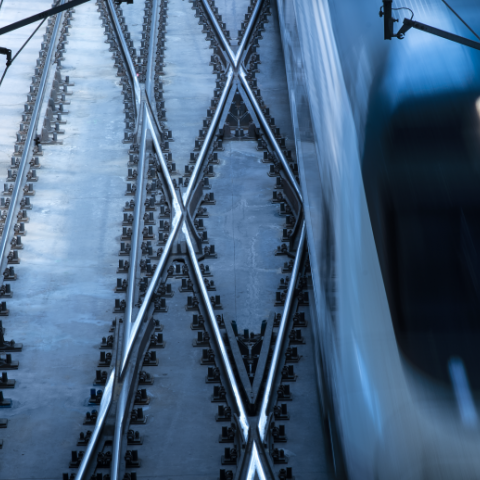
Spain has developed the second high-speed network in the world with one of the lowest construction costs per kilometre compared to other countries with this mode of transport and the lowest among European Union countries.
Spain has managed to develop the most extensive high-speed network in the EU with the lowest average construction cost. And it has done so with very high design and quality parameters, at the forefront of the sector, in relatively quick times and without major budget deviations. This is the main statement included in the new report 'Efficiency of the Spanish sector in the development of high-speed railways', elaborated by the engineering and consultancy firm Ineco, which deals with the efficiency of the Spanish high-speed rail model.
A comparative analysis of theTransit Costs Project database, together with the rest of existing studies, allows Ineco to conclude in this report that Spain has developed the second high-speed network in the world with one of the lowest construction costs per kilometre compared to other countries with this mode of transport and the lowest among European Union countries. Spain builds high-speed trains at an average cost per kilometre of 17.7 million Euro, compared to 45.5 million Euro in the rest of the countries with high-speed trains, more than twice over.
The study also extends the traditional perspective of construction to cover the entire life cycle of the infrastructure and includes the costs of operation and maintenance which, although to a lesser extent, reinforce the leading position of the Spanish model. Despite having a more extensive high-speed network, and therefore more expensive to maintain, the data show that Spain is in line with or below the European average. And all this taking into account the choice of the Spanish model for ballast, with higher maintenance cost rates than ballastless track. In this line, and given the weight of maintenance compared to the cost of construction, the report points out that the Spanish strategic choice for ballast has not implied an increase in the global cost of high speed in a long-term perspective.
These production costs have not diminished the quality of the Spanish product. In fact, the study shows that no comparable country has a better quality-to-cost ratio than Spain, and that those countries that achieve higher scores on the quality index do so at the cost of more than proportional increases in their cost per kilometre ratio.
Elements contributing to the efficiency of the mode
The report analyses both the costs and the technical advantages of the model, the exploitation of economies of scale, the technological, institutional, cultural and/or political context.
Economic factors with a direct impact on cost contribute, as highlighted in the report, to maintaining the efficiency levels of the model. Inputs such as labour costs in Spain, as well as land costs (average per hectare), in both cases lower than the EU average (thanks in part to the low population density) have an impact, albeit a small weight, on the total construction cost.
Other issues such as the social and political consensus around high speed, the creation of in-house technology,the exploitation of the learning curve, the integrated management of the development of the entire network through multiple contracts of relatively small size (which ensures a plural and competitive industrial sphere, avoiding a stagnation of knowledge in one or a small number of companies) and the management and standardisation of some design parameters, are just some of the important aspects that have made the success of the Spanish model possible and which are analysed in the report. This consensus, in addition to facilitating processes and reducing production costs, has allowed for a strong public sector push regardless of political cycles or territorial spheres.
A commitment that, together with the highly qualified talent that resides in it and with the involvement of Adif, the support of Ineco and the Public Administration as a whole, has facilitated a high level of investment and a clear commitment to the railway until today as a key element for sustainability and energy transition in mobility. The private sector, for its part, has been able to build on this momentum. Spanish construction companies, manufacturers and engineering firms have been able to develop and strengthen their know-how, specialisation, technology, innovation and, fundamentally, contribute value throughout the entire infrastructure life cycle.
And, above all, the country has created in these years a Spanish culture of high speed that is embodied in a commitment to the project and a pride in the participation of the companies and professionals involved that reduces conflicts and speeds up solutions.
The British case
At the other end of the cost spectrum is the UK, with figures nine times higher than the Spanish model. The study analyses the reasons that may favour this difference between the two countries after the recent cancellation of phase 2 of the British high-speed HS2. A project that has experienced a large deviation in cost and time.
The report compares the Spanish case with that of the UK in all its dimensions. Undoubtedly, labour costs in engineering and construction are comparatively lower in Spain. The Spanish network passes through some of the most sparsely populated regions of the country compared to the UK, where high population density and dispersed urbanisation lead to considerable cost increases. However, as the report reflects, this is not the only difference, being other technological and institutional factors of greater importance to explain the great difference in the evolution of both high-speed experiences.
The strategic conception of networks is another differentiating factor. While in Spain there is a clear consensus on high-speed rail and its mission in the modernisation of the country and its opening to the outside world, in addition to the purposes linked to mobility itself, HS2 was born as an action to improve railway capacity and connectivity on existing axes which were already operating at full capacity, with its high-speed railway character being a secondary factor that has hindered the progress of the project.
The uniqueness of the legal context and governance in the construction of large transport infrastructure in the UK makes the development of the entire conceptual and planning phase a complex, bureaucratic and fragile process, which is rooted in the Anglo-Saxon legal framework and imposes much higher costs than in Spain in this phase.








